1908 Goldfield
The beginning of a visual change in Central, Nevada.
By Robert Stoldal
updated August 13, 2022
(This report provides a brief overview of the post cards printed by The Goldfield News newspaper covering the years 1906 to 1908 in Goldfield, Nevada.0
(this report was updated on February 8, 2021. February 9, 2021, February 11, 2021, September 9, 2021, October 22, 2021 and August 13, 2022)
Fortune Seekers
Like all mineral-based boom towns, Goldfield, Nevada not only attracted ore seekers but other dreamers with tomorrow in their blood.
Goldfield holds a unique place in Nevada’s history. Unlike most mining boomtowns of the southwest that turned into ghost towns, Goldfield today, alive and building a future
Goldfield started as a community of tents in late 1903. In less than forty-eight months, it would have the title of the largest city in Nevada.
Except when the United States took its official census every ten years, all the population numbers of Goldfield between 1902 and 1910 are estimates.
In its online report, “Southern Nevada, the Boomtown Years,” the University of Nevada Special Collections says within thirty-six months, “By the end” of 1906 Goldfield’s “the population had reached 30,000.
In its online report, “Goldfield’s Building Boom,” the Goldfield Historical Society says by 1907, Goldfield grew “to be the largest city in Nevada with a population of over 20,000 people.
A major shift in how the community operated began in 1907 and over the next 36 months, a dramatic decline in the population of Goldfield would take place. According to the U.S. Census, the population of Goldfield in 1910 was less than 5,000.
For a discussion of the population history of Goldfield, here is a chart from Wikipedia. The website cites its source as the U.S. Census.
Historical population estimates of Goldfield
Year Pop. ±%
1902 36 —
1903 400 +1011.1%
1904 1,600 +300.0%
1905 8,000 +400.0%
1906 20,000 +150.0%
1907 18,000 −10.0%
1908 15,000 −16.7%
1909 10,000 −33.3%
1910 4,838 −51.6%
1920 1,558 −67.8%
1930 692 −55.6%
1940 554 −19.9%
1950 336 −39.4%
1960 184 −45.2%
1990 655 +256.0%
2000 440 −32.8%
2010 268 −39.1%
With population estimates of 18,000 to 30,000, between 1906 and 1907, Goldfield became the largest city in Nevada.
Unlike many boomtowns of the southwest that turned into ghost towns and disappeared today, Goldfield is building a new future, a future that includes preserving its history.
Compared to 2010, the 2020 U.S. census reveals Goldfield’s population is up more than ten percent to 298.
Based on the town’s current energy, including mining in the area, the restoration work on the historic high school, the expansion of the town’s radio station, Goldfield’s population is on its way to 400.
If you are planning a visit, make a stop at the Goldfield Historical Society. http://www.goldfieldhistoricalsociety.com/
Like most boomtowns, among those early entrepreneurs attracted to Goldfield were newspaper publishers and photographers.
Among the many producers of Goldfield post cards during its boom period were the town’s newspapers.
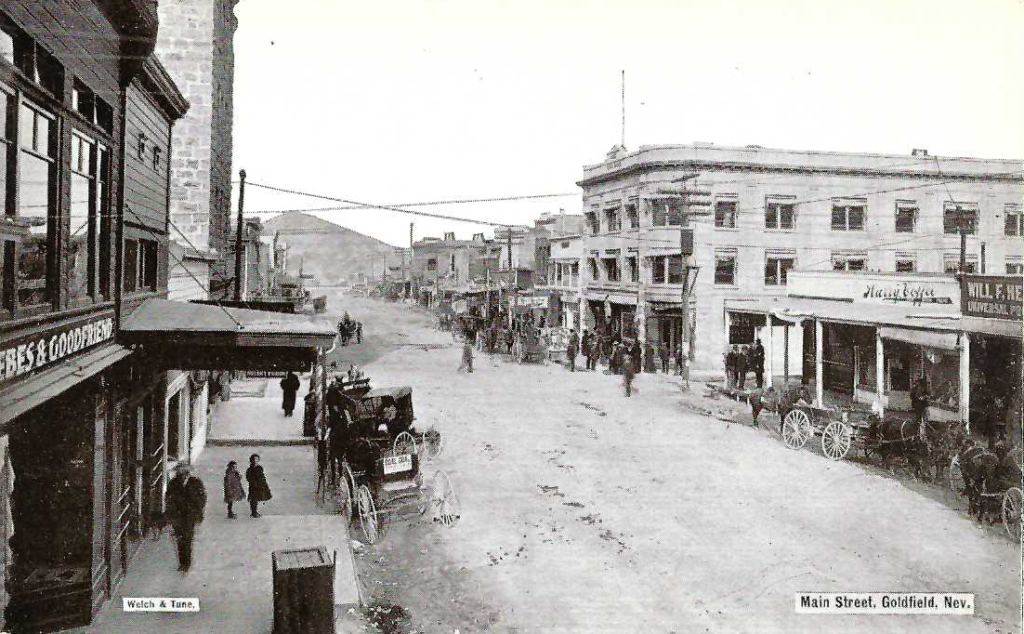
This image shows Main Street in Goldfield in the late fall of 1908. The post card is part of the 32 card set of Goldfield published by The Goldfield News Newspaper.
Based on newspaper articles, postmarks, and different style backs, there are at least five different periods when the newspaper produced post cards of Goldfield.
June 1908 is the earliest known postmark on a post card in the printed series.
The earliest known postmark for a real photo post card used in the printed version is May of 1908.
Most of the views the newspaper printed as post cards are from 1908. There is at least one image from earlier years.
In the boom years of Goldfield, several publications fit into the category of newspapers.
This report will focus on the two newspapers connected to the post card images in this report; the Goldfield Tribune and the Goldfield News.
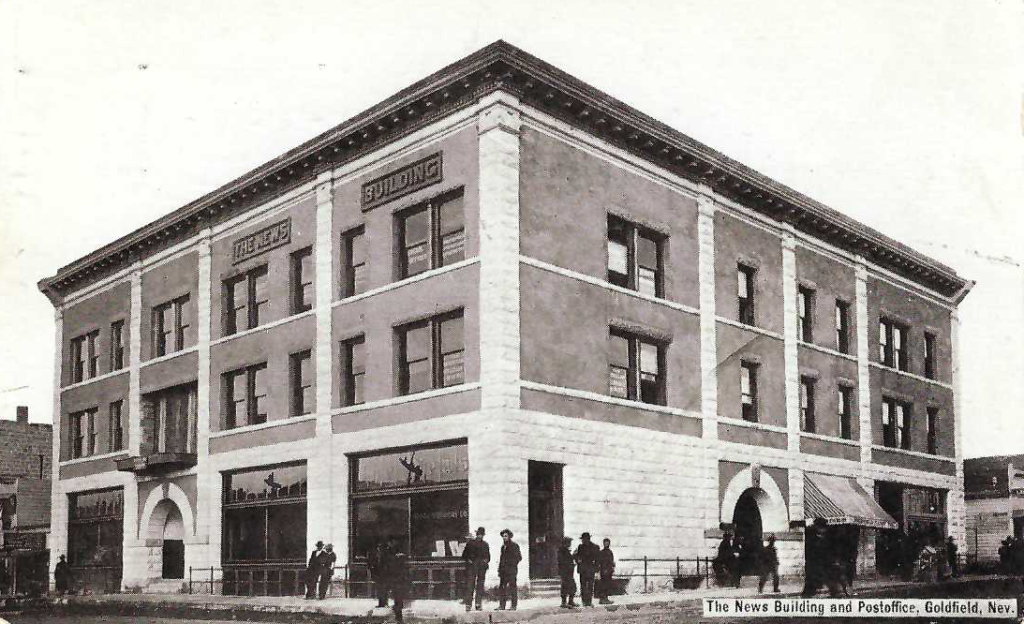
4. The News Building and Postoffice, Goldfield, Nev.
On April 29, 1904, the first issue of the Goldfield News went on sale.
Less than two years later, on January 19, 1906, the weekly Goldfield News was purchased by Charles S. Sprague.
In addition to the weekly Goldfield News, Sprague added an evening edition, the Daily News, in February of 1909.
Publication of both the daily and weekly editions of the newspaper continued until March of 1911.
That year the Goldfield News was purchased by the town’s other daily newspaper, the “Goldfield Tribune.”
At this point, the Tribune continued as a daily, and the Goldfield News went from a daily to a weekly under the name “Goldfield News and Weekly Tribune.”
Over the next several decades, the Goldfield News would change owners, publication dates, and coverage, including Beatty and Tonopah
Today the Goldfield Tribune and News are known as the Tonopah Times-Bonanza and Goldfield News.
Online access is available for the early editions of the Goldfield News and later issues following the merger with the Tribune.
The pre-merger issues of the Goldfield Tribune are currently only available on microfilm at libraries and universities.
June 1908 “A Dozen Post Cards.”
The first public notice of post cards published by The Goldfield News is in the newspaper’s June 20, 1908 issue.
The paper promoted “a dozen post card views of the town and camp of Goldfield, including the best buildings and mines, street scenes, typical camp pictures, together with the latest panorama of Goldfield, beautifully printed in two colors.”
The newspaper told readers if they wanted the twelve cards, they should “send 50 cents to The Goldfield News (Stationery Department).”
The newspaper’s advertisement stated the twelve post cards included “views” of Goldfield “the town and camp” including “street scenes,” the “best buildings,” and “mines.”
At the time, the newspaper also offered the “latest” panorama photograph of Goldfield.
Several months later, the newspaper offered twenty “new” post cards to its original 12 cards.
October 1908 “A new set of Thirty-two picture postals.”
“New” is the important word in the October announcement, “a new set.”
In the October 3, 1908 issue of The Goldfield News, the newspaper announced it was creating “a new set of Picture Postals comprising thirty-two different views in and about Goldfield.”

Post card 25 in the series, “One of Goldfield’s Heaviest Producing Leases.” The sign on top of the headframe says “MOHAWK-JUMBO –LEASE CO.-”
This is an interesting selection to include in a series to be released in January of 1909, as most of the important leases came to an end in 1908.
In the October 10, 1908 announcement, the newspaper provided a clue to help date the photographs on the post cards.
The newspaper said, “the views were taken within the past month and comprise all the principal mines, buildings, residences, interiors, street scenes, characteristic mining camp scenes, etc., and a handsome double panorama of Goldfield.”
“Within the past month” clearly means many photographs used on the post cards are from September of 1908.
One of the photographs used on a post card in the set goes back to 1906.
The Goldfield News sent the new September 1908 photographs (likely to California) to create printing plates. When printed, the newspaper referred to the pictures as “cuts.”
Starting with the October 3 edition, the newspaper ran the same post card advertisement every week through December 1908.
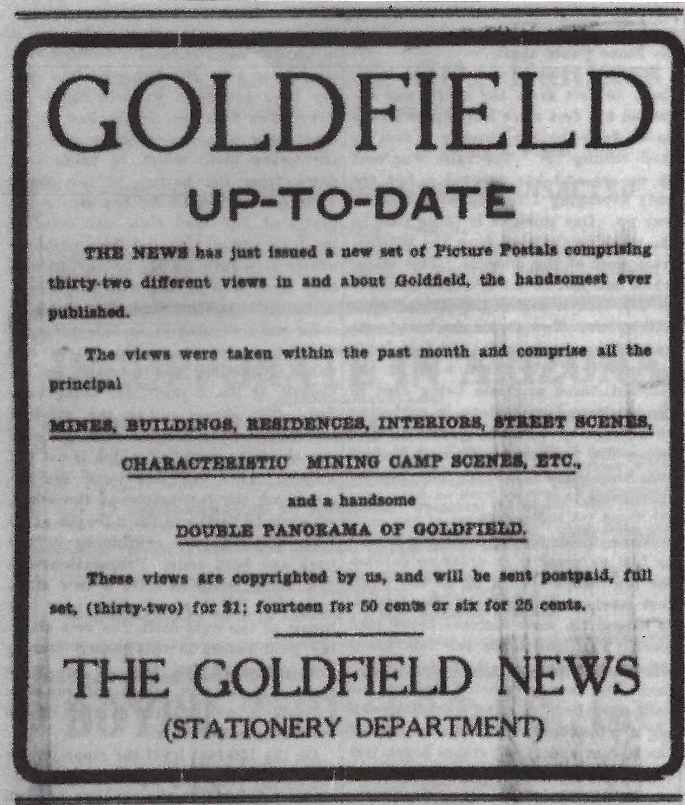
Display advertisement The Goldfield News October 3, 1908 page three.
Then in the first issue of 1909, January 2, The Goldfield News had a page one story, “Nevada for the Year 1908 in Picture and Story.”
Despite the headline, the page one story said the expanded issue would have to wait.
“Because of a failure to receive cuts on time,” the newspaper said it was unable to publish its “illustrated edition this week.” The editor promised the next issue “will be all the more profusely illustrated by reason of the additional time.”
The newspaper added, “The edition will contain some 40 half-tone engravings, including a panoramic view of the Goldfield district.”
Part of the planned promotion for the new year was the release of a 32 post card series the newspaper had been working on and promoting for several months.
The eighteen-page illustrated edition hit the newsstands on January 9, 1909. There were thirty-eight photographic images in the paper. The newspaper described thirty of the images as “smaller cuts.”
It was those thirty “smaller cuts” plus two other images that would make up the “new set” of post cards that could be “souvenirs” or they could be used for “advertising purposes.”
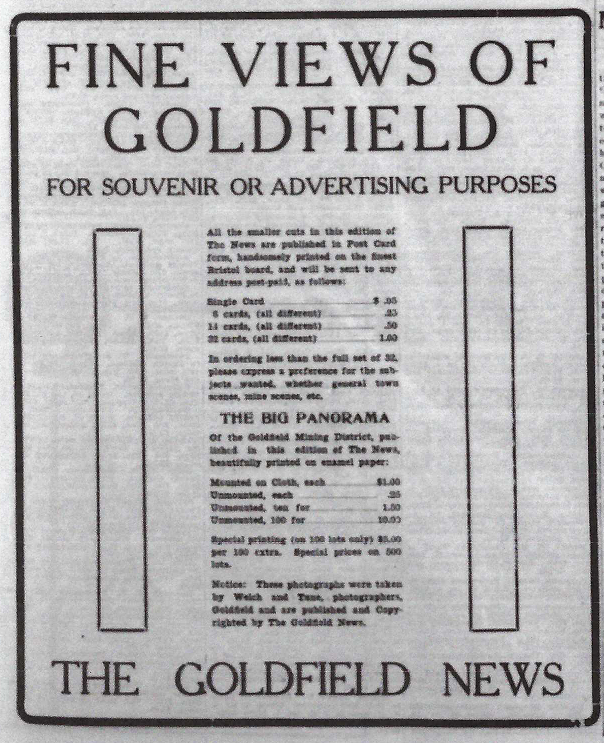
At the end of the advertisement, is a “notice;” telling readers “Welch and Tune took these photographs…copyrighted by The Goldfield News.”
The majority of the photographs on the post cards are Welch and Tune’s. The work of pioneer Goldfield photographer Pers Edward Larson is also featured on the cards.
A review of U.S. Copyright records shows the newspaper did not copyright the images.
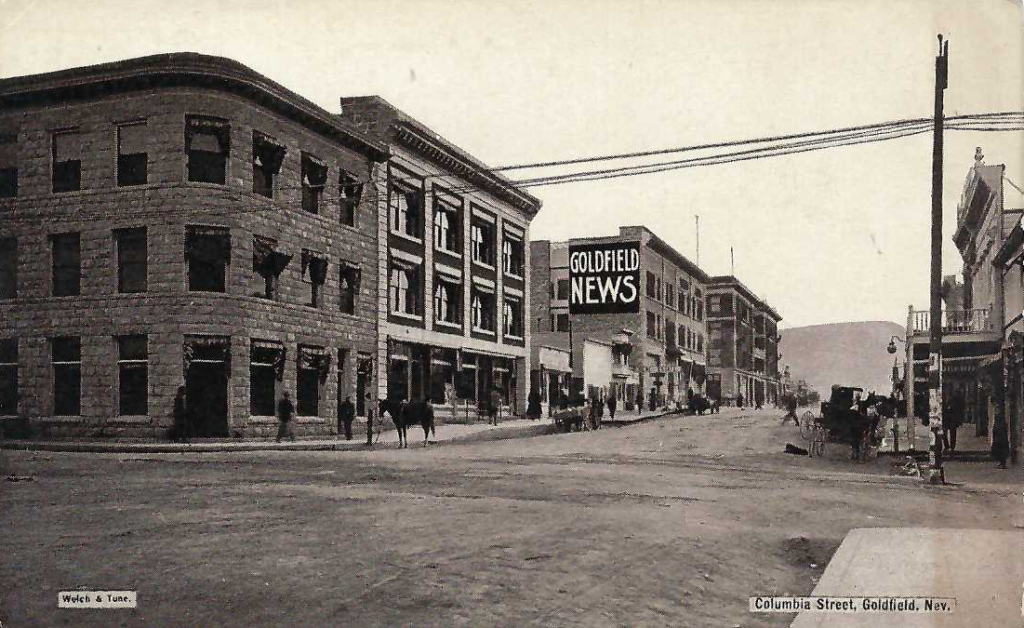
3 Welch & Tune Columbia Street, Goldfield, Nev.
Charles Sprague, the Goldfield News owner, had photographs taken inside and out of his home and the “cuts” were included in the January 9th issue of the newspaper.
The caption that accompanied the two photographs in the newspaper said, “There are many well-built and handsomely furnished houses in Goldfield that afford all the comforts of “civilizations,’ having steam and water heat, electricity for lights and good and every accessory of modern houses.”
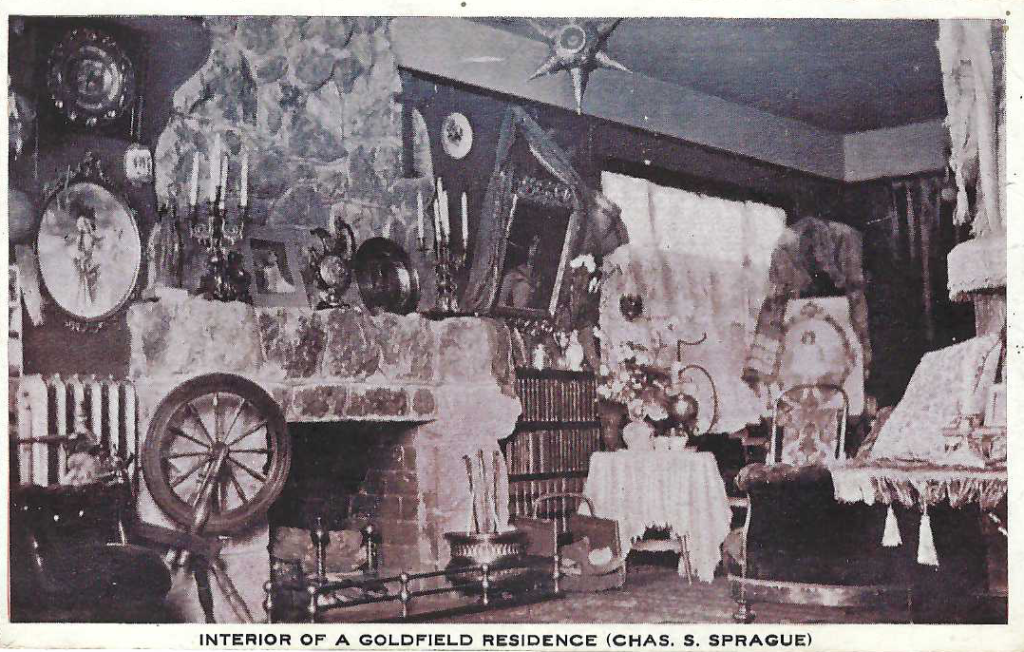
Currently in the master list as number 18; “Interior of a Goldfield Residence. (Chas. S. Sprague)”
In the coming years, the newspaper would reprint the best sellers from the series of 1908 views.
The exterior and interiors views of the Goldfield Hotel taken when it first opened appear to be the post card the newspaper reprinted for the next two years.
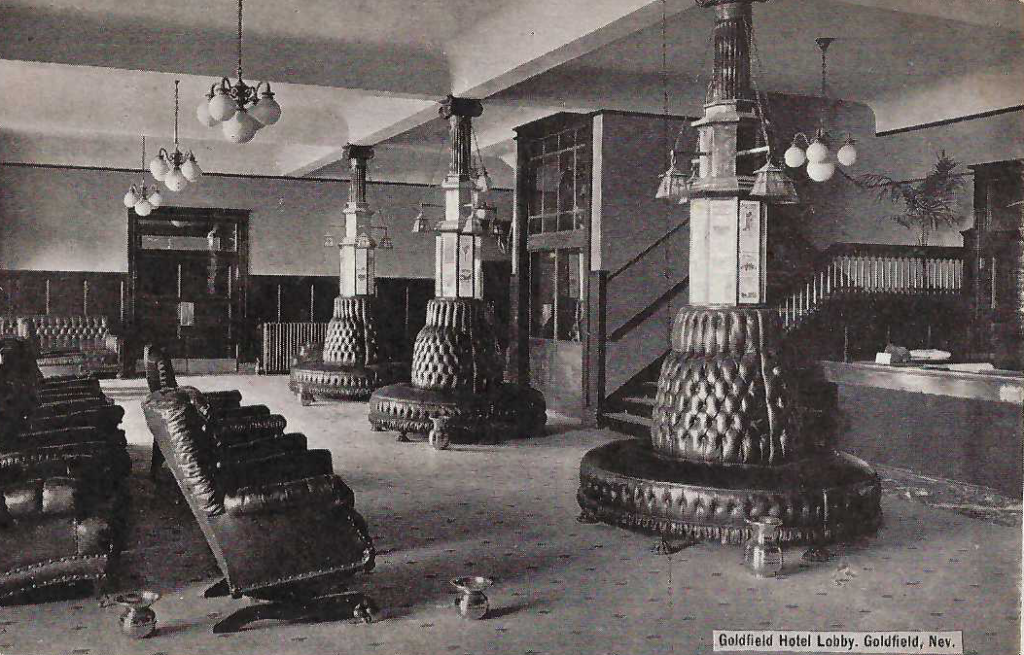
Dating the Images
Based on when the Goldfield News made the public offering of the post cards, January of 1909, it is clear, the majority of the images are from 1908.
The images, the postmarks, and the different style backs help determine when the photographs were produced.
The different style backs help determine when the post cards were printed and reprinted.
Photographers
Pioneer photographers were looked upon by any mining boomtown as an essential component of development.
Goldfield had several pioneer photographers.
The earliest of record was I. W. Booth, who started in Tonopah in 1903 and moved full time to Goldfield in early 1904.
By the fall of 1904 Booth had moved into real estate and mining and sold his photography business to Arthur Allen, who had just moved to Goldfield.
“Arthur Allen” is, in fact, a stage name. Despite credit lines showing “A. Allen Photo” on cabinet cards, and post cards, Arthur Otis Eppler used Allen as the name of his store both in Goldfield, Nevada, and San Francisco, California. Eppler’s use of his stage name Arthur Allen, starting in early 1903, would later cause confusion, with a San Francisco newspaperman whose name was Arthur M. Allen, who moved to Goldfield in 1906.
The story of Eppler, a well-known pioneer photographer, and a person who fits the historical description of “Colorful” will be the focus of an upcoming report on Captain History.
Details of Allen’s time in Goldfield and who Allen was still needed to be unfolded. He is often confused with a Goldfield newspaperman of the same name who moved into the area in 1906.
Eppler, using the business name Allen Photo Company would be in business from 1904 to 1910, the longest of any Goldfield-based photographer during the communities heyday.
Next in Goldfield was Per Edward Larson. For more than two years Larson operated the largest photography business in Goldfield.
From studio work to on-location, Larson not only recorded the mining boom, but also produced material for the community and the tourist trade.
Larson left Goldfield as the air in the boom began to evaporate.
In the summer of 1907, the photography partnership Frank E. Welch and Robert H. Tune arrived in Goldfield.
After being in town for six months, the January 26, 1908 issue of the Goldfield Chronicle described them as “well-known photographers.”
The two became the most important photography outlet in the city when Larson decided to change careers.
The two men bought Larson’s “photography establishment, including an extensive line of pictures, postals, and stationery” in January of 1908. Included in the purchase were the rights to all of Larson’s photographs.
(“Photographer Larson Sells to Welch & Tune,” January 26, 1908, Goldfield Chronicle, Page four.)
Larson left Nevada and would not return to the photography business.
And like Larson, when Welch and Tune left Nevada, the partnership ended, and neither would turn to photography as a profession.
Welch and Tune’s decision to leave photography occurred not long after a fire in 1909 destroyed their business.
The “fire started,” according to newspaper accounts, “in the rear of the photographic studio of Welch & Tune.”
“Hundred Thousand Loss By Fire in Goldfield,” April 16, 1909, Salt Lake Tribune, page ten.)
The equipment was replaced with insurance.
The destruction of the photographs and negatives from their own work and that of Larson destroyed an essential part of the visual history of Goldfield.
However, both Larson and Welch and Tune had turned many of their photographs into post cards preserving some of their work
The “Welch & Tune” credit line appears on the face of fourteen of the original thirty-two post card set published in 1909 by The Goldfield New.
In addition, several other photographs used in the series are uncredited Welch and Tune photographs.
Post card thirteen in the master list, Interior Jno. S. Cook & Co. Bank, Goldfield, Nev. is a Welch & Tune photograph
The second uncredited Welch & Tune photograph is number 16, titled “Goldfield Hotel Lobby, Goldfield, Nev.”
Post card number 20, “Gambling in Goldfield, Nev.” is a Welch & Tune photograph. The Welch & Tune credit line does not appear on the post card.
A Welch & Tune photograph was also used for post card 21, “A Goldfield Dance Hall, Goldfield, Nev.”
The fifth uncredited Welch & Tune photograph is found on post card number 30, “The Famous Florence Mine and Mill, Goldfield, Nev.”
A real photo post card with the same view is postmarked May 31, 1908. The sender noted on May 30, “Snowing awfully this a.m.”
In addition to Welch & Tune, so far, two of the 32 photographs in the post card series were taken by Larson.
At this point, the photographers who took twenty-one of the 32 photographs used for this post card series have been identified.
And, it is likely the remaining uncredited views are the work of Larson and Welch & Tune.
Post Card Paper Imported from England
When The Goldfield News announced the production of thirty-two post cards of “fine views of Goldfield,” it told its readers the cards were “handsomely printed on the finest Bristol board.”
“Bristol board” is thin pasteboard produced in the early 1800s in Bristol, located in the southwest part of England.
“Bristol board,” a term still used today, means the same as it did in the 1800s; the use of high-quality paper pasted together provides a very white and thin board.
U.S. Tariff battles in Congress began in 1908 over imported paper material, including “Bristol board,” that would eventually drive up the paper’s cost.
However, the timing of the tariff battles and when the Goldfield post cards’ were printed means the Bristol board used by The Goldfield News was imported from England.
And, the newspaper said it was using the “finest Bristol board.”
Many of the well-preserved post cards from the 1909 Goldfield News series still maintain the “very white” appearance.
There is a noticeable difference between “The News” post cards on the Bristol board and the Tribune cards printed on light brown pasteboard.
Master Check List
This list is based on all the known versions of the post cards initially printed by The Goldfield News and later reprinted by the Tribune. The list includes all the “smaller cuts” mentioned in the January 9, 1909 issue of The Goldfield News.
The individual post cards are not numbered. The numbers in this list are for the purpose of cataloging.
The numerical order starts with views of the community of Goldfield, followed by mining locations.
The numbers in this list are used in other sections of this report to identify the post cards.
The caption and when there is a credit line both follow the same format on each post card. The credit line is on the card’s left side, and the caption is on the right side.
Both caption and credit lines were printed with dark ink in white horizontal boxes.
The spelling, abbreviations, and punctuation on the post cards are used in the master checklist.
The Master List
Captions
1. Welch & Tune Main Street, Goldfield, Nev.
2. Welch & Tune Main and Ramsey Sts., Goldfield, Nev.
3. Welch & Tune Columbia Street, Goldfield, Nev.
4. The News Building and Postoffice, Goldfield, Nev.
5. Welch & Tune Court House and Jail, Goldfield, Nev.
6. Welch & Tune Goldfield’s Fire Department, Goldfield, Nev.
7. Welch & Tune Sundog Ave. School, Goldfield, Nev.
8. Welch & Tune West Crook St. School, Goldfield, Nev.
9. Welch & Tune High School, Goldfield, Nev.
10. Welch & Tune High School Assembly, Goldfield, Nev.
11. One of Goldfield’s Churches, Goldfield, Nev. (v)
12. Welch & Tune First National Bank Building, Goldfield, Nev. (v)
13. Interior Jno. S. Cook & Co. Bank, Goldfield, Nev.
14. Hotel Casey, Goldfield, Nev.
15. Welch & Tune Hotel Goldfield, Goldfield, Nev.
16. Goldfield Hotel Lobby, Goldfield, Nev.
17. Dining Room, Hotel Goldfield, Goldfield, Nev.
18. A Goldfield Residence. (Chas. S. Sprague)
19. Interior of a Goldfield Residence. (Chas. S. Sprague)
20. Gambling in Goldfield, Nev.
21. A Goldfield Dance Hall, Goldfield, Nev.
22. Pioneer Buildings, Goldfield, Nev.
23. Welch & Tune General View Mines, Goldfield, Nev.
24. Welch & Tune General View Mines, Goldfield, Nev. (Different view.)
25. One of Goldfield’s Heaviest Producing Leases.
26. The Famous Florence Mine and Mill, Goldfield, Nev.
27. Florence Mine and Mill, Goldfield, Nev.
28. Combination Mill and Mine, Goldfield, Nev.
29. Welch & Tune Goldfield Consolidated Mill, Goldfield, Nev.
30. The Mohawk Mine and Ore Bins, Goldfield, Nev.
31. High Grade Ore Vault Deposit, Mohawk Mine, Goldfield, Nev.
32. Nevada-Goldfield Reduction Works, Goldfield, Nev.
33. 20 Head Mule Team en route to Death Valley, via Goldfield, Nev.
Notes on the Post Cards in the Master Checklist
1 Welch & Tune Main Street, Goldfield, Nev.
The January 9, 1909 newspaper story told readers, “Goldfield today is far different from what it was two years or even one year ago, in its physical appearance. The streets are now graded and macadamized and lined with some of the finest buildings to be found anywhere in the country. Main Street is the chief business street. The view gives only a part of Main Street, the business section of which extends six blocks.”
3 Welch & Tune Columbia Street, Goldfield, Nev.
The January 9, 1909 newspaper story told readers, “Columbia Street has most of the larger and more recent business blocks.
In the foreground is the Goldfield Consolidated Mining Company’s building, followed by the Registration Trust Company, the Montezuma Club, and the News Building, then the Hotel Goldfield.”
Hugh A. Shamberer in his book “Goldfield” uses this Welch & Tune photograph.
Shamberger describes the “Consolidated Mining Company Building” as the Nixon-Wingfield building as the two men controlled Consolidated.
He also provides additional information regarding the “Registration Trust Company building.
On page 125 Shamberger points out that “The Nixon-Wingfield building” is seen on the southeast corner of Columba Street and Ramsey Avenue. He adds” next to it on Columbia Street is the large-windowed Ish-Curtis Building.”
Shamberger did not identify the three smaller buildings in the photograph. He pointed out the “Large building up Columbia street, is the Montezuma Club with the eye-catching GOLDFIELD NEWS sign on its north wall. Adjoining it is the News building, both of these buildings were destroyed in the 1924 fire. Still farther south along Columbia Street, is the Goldfield Hotel.”
(Historic Mining Camps of Nevada Goldfield, by Hugh A. Shamberger, 1982, Nevada Historical Press, Carson City, Nevada, page 123.)
8 Welch & Tune West Crook St. School, Goldfield, Nev.
Hugh A. Shamberer in his book “Goldfield” uses this Welch & Tune photograph on page 144.
Shamberer’s caption reads “The West Side (West Crook Street) School constructed during 1908. The building housed manual training and domestic science classes from 1910 to 1917 when it was taken over by a School of mines which operated from 1917 to 1920.”
(Historic Mining Camps of Nevada Goldfield, by Hugh A. Shamberger, 1982, Nevada Historical Press, Carson City, Nevada, page 144.)
18 and 19 Sprague Residence.
Neither post card 18 A Goldfield Residence (Chas. S. Sprague) or 19 Interior of a Goldfield Residence (Chas. S. Sprague) have been seen with the shield style back of a Goldfield News post card.
While both views are found in the January 9, 1909 issue of The Goldfield News it is possible the views were NOT part of the 32 card series issued by the newspaper.
Currently, the two titles are listed in the master list as cards 18 and 19.
The exact two images with the same captions appear on post cards printed by the Clark Engraving and Manufacturing Company of Milwaukee, Wisconsin.
Unlike the post cards in the newspaper series, the Clark cards have white borders and brown and black coloring of the images.
Clark Engraving was primarily a stock certificate printing company.
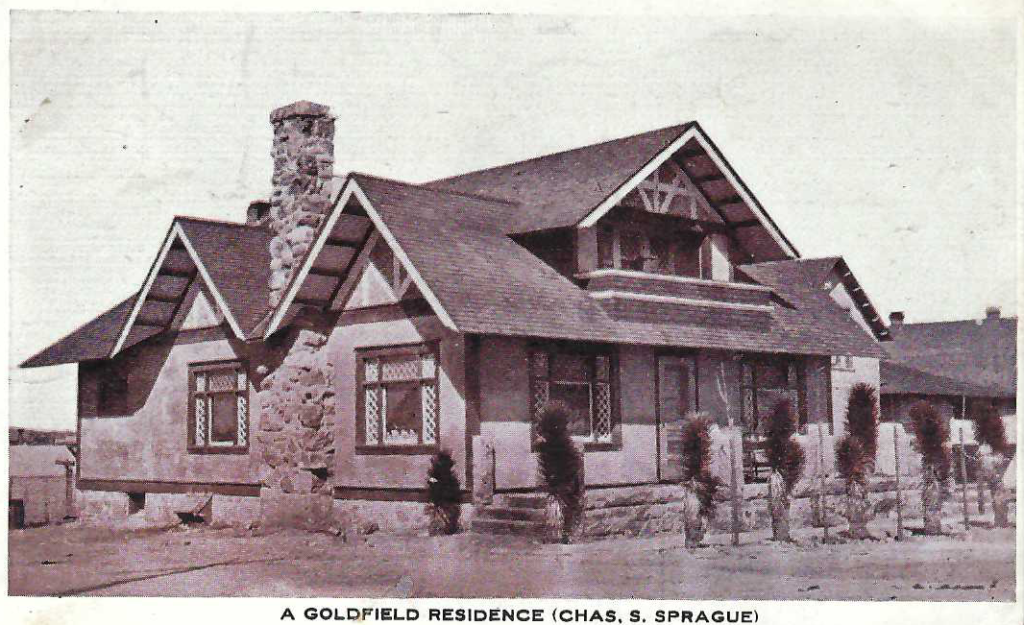
The Clark Engraving post card of the exterior of the Sprague residence listed as number 18 in the master list.
20 Gambling in Goldfield.
20. Gambling in Goldfield, Nev. Welch & Tune took the photograph used for this printed post card.
This was one of the most popular post card titles when it was first printed and today is one of the most sought-after images.
The photograph has been used several times by different post card publishers.
Welch and Tune initially issued the image on a real photo postcard titled “Merchants Hotel.”
Welch and Tune later released the same real photo post card with the original caption “Merchants Hotel” blacked out, and replaced it with “GAMBLING IN GOLDFIELD.”
Why the change? Was the owner of the hotel J. Casey McDonnal, upset with the Welch and Tune when by caption had moved his hotels from Columbia to Goldfield or did Welch and Tune think the post card would sell better with a generic gambling caption?
Casey’s hotel was located in Columbia, named after the nearby Columbia Mountain, which in turn was named after Christopher Columbus.
Here is a brief overview of Columbia, provided by the University of Nevada Special Collections; “Columbia…is a suburb of Goldfield and is located one-mile north of Goldfield. It boomed in 1902 when gold was discovered at the base of the Columbia Mountains. Within two years, the town had businesses, a bank, post office, chamber of commerce, a lodge, city hall, the Columbia Club, and a drug store. A weekly newsletter, “The Goldfield Review,” was locally printed in 1904. Its mines were known for their rich, oxidized gold ore, and by 1907, the population had reached 1,500. With the construction of the Tonopah and Goldfield Railroad Depot, transportation costs plummeted, and a ten stamp combination mill was built. However, Columbia’s growth was dependent on Goldfield, and when Goldfield began to decline in 1908, Columbia did as well.”
The photograph used for the “Gambling” post card number 20 shows seventeen people, including one woman in a small casino inside the Merchants Hotel.
In the photograph is a bar and bartender, a roulette wheel, a crap table, and a faro game. With the exception of the bartender, all the men are wearing hats or caps.
Welch and Tune took a series of photographs in the Merchants Hotel casino and bar that night.
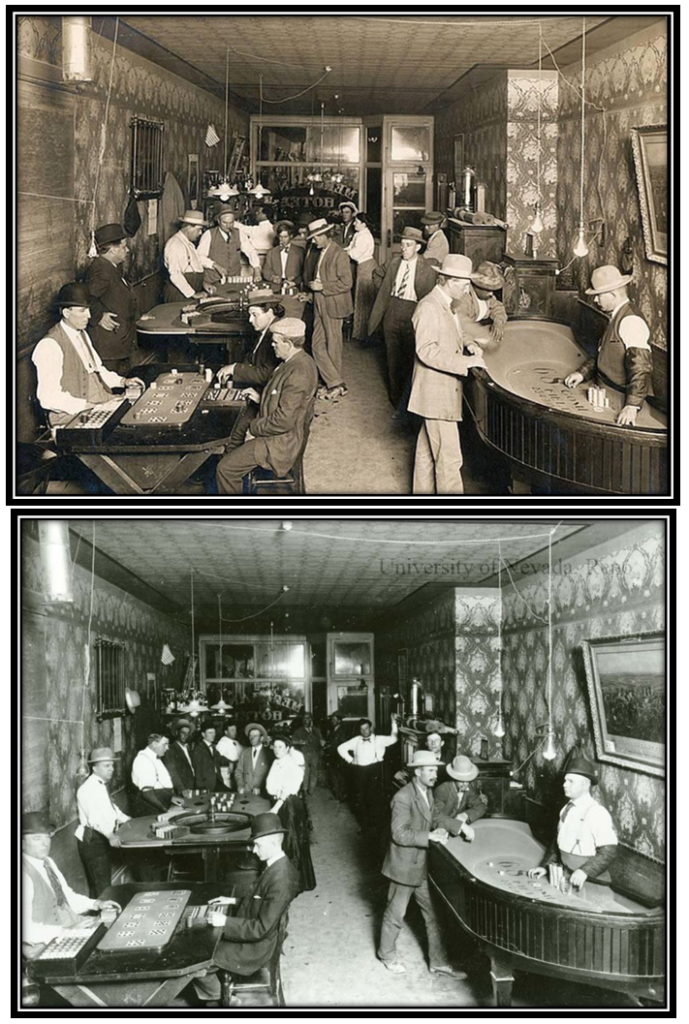
At least three different photographs have survived. Welch and Tune kept their camera in the same place everything from the people to the clothes they were wearing changed. On the gaming table, chips were added, subtracted, or just moved during the time elapsed between photographs.
In the post card photograph, the woman is standing next to the bar in the background.
In the UNR photograph, the woman is next to the roulette wheel. Note the chips at each game have been moved, and only one person is playing Faro.
In the third known photograph among the changes, the woman is now next to the crap table on the rights side of the photograph.
The image is seen on page 17 of Shamberger’s book, “Historic Mining Camps of Nevada Goldfield.”
In the first photograph, a ‘candid’ look at the gambling club, in the second and third known photographs more and more people are posing and looking at the camera. In the third photograph, all but two people are looking at the photographer.
It is not known which photograph was taken first and if more than three pictures were produced.
A colorized version of “Gambling in Goldfield Nev.,” was published by the Grey News Company of Salt Lake City, Utah.
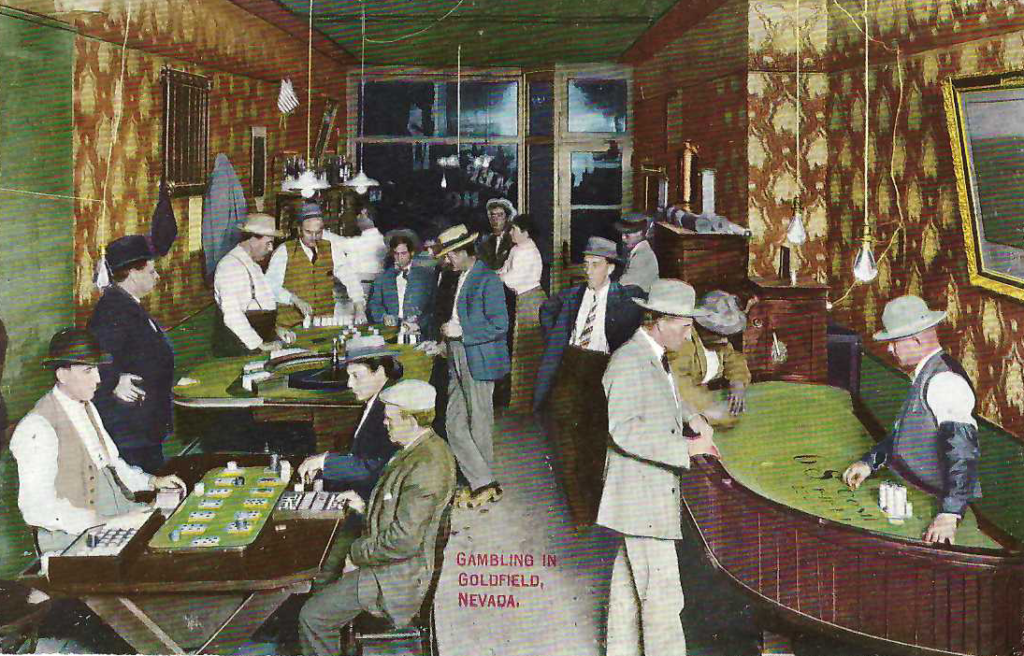
The printing quality provides good detail and realistic colors, making the Grey News post cards a desirable set.
The Grey’s company had the on train and depot news stand franchise for the Union Pacific from San Francisco to Salt Lake City and the rail lines from Reno south to Tonopah.
Grey published a series of ten color post cards of Goldfield and Tonopah. Of the ten, 6 are of Goldfield, and 4 of Tonopah.
In addition, the first card in Grey’s series of central Nevada, BIRD’S-EYE VIEW, GOLDFIELD, NEVADA, “NO 4001” is the same photograph used by The Goldfield News for its panoramic two-card foldout view of the city. The Grey card features only the center of the panoramic photograph.
Grey published a total of three post card views also seen in The Goldfield News 32-card 1909 set.
- COLUMBIA STREET, GOLDFIELD, NEVADA, Grey 4003 is the same view published by The Goldfield News, 3. Welch & Tune Columbia Street, Goldfield, Nev.
- GAMBLING IN GOLDFIELD, NEVADA, Grey 4006 is the same view published by The Goldfield News, 20. Gambling in Goldfield, Nev.
- GENERAL VIEW OF MINING DISTRICT, GOLDFIELD, NEV. Grey 4008 is the same view published by The Goldfield News, 24. General View Mines, Goldfield, Nev.
Gray News color version of The News “Gambling” in Goldfield postcard.
A page-one story in the Nevada State Journal on April 13, 1911, describes the end of the Merchants Hotel and casino. “FAMOUS DESERT HOTEL BURNED Merchants Hotel — Destroyed by Early Morning Blaze.” https://newspaperarchive.com/nevada-state-journal-apr-13-1911-p-9/
A Welch & Tune’s photograph provides an exterior view of the Merchants Hotel, and the caption has the correct location of the resort. This view was not included in The Goldfield News 32 postcard set.
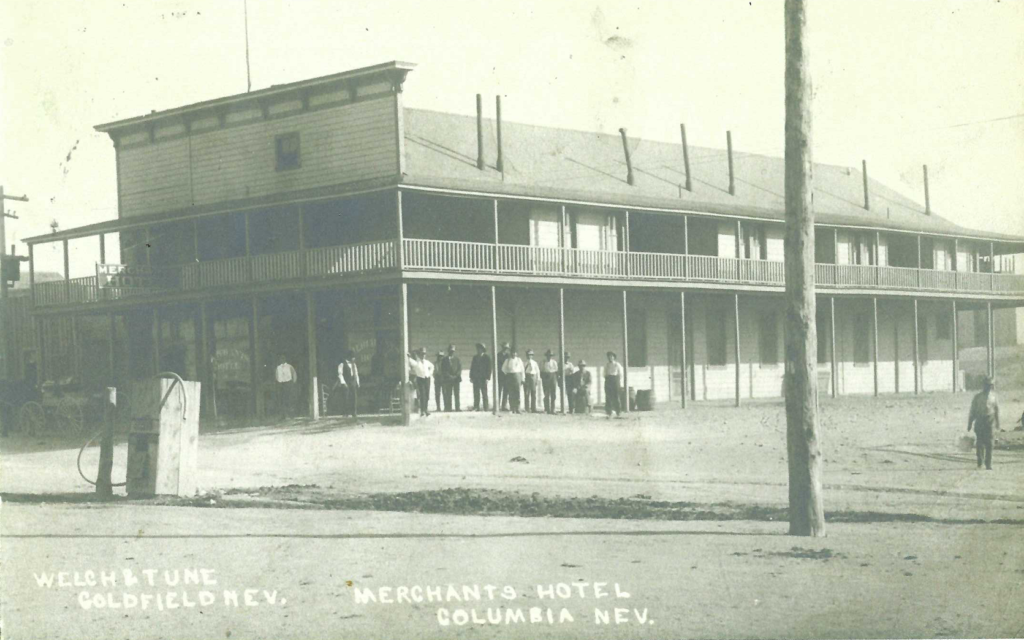
21. Goldfield Dance Hall.
More than forty people are visible in this dance hall masquerade event at an unnamed “Dance Hall.” The caption reads, “A Goldfield Dance Hall, Goldfield, Nev.” That is the exact title found on the Welch & Tune real photo post card of the same scene. However, below the caption on the real photo card, it says “Eckstein & Owens Props.”
Details about the name of the dance hall or who Eckstein and Owens were have not been uncovered. A business called the Eckstein and Kelly’s Dance Hall was in business in late 1908 and early 1909.
Another clue as to whose dance hall it was is found on the sign in the background on the right side, which reads “THIS IS STRICTLY A UNION HOUSE.”
Based on known postmarks, the photograph is from the latter part of 1908.
22. Pioneer Buildings, Goldfield, Nev.
The image on The Goldfield News post card issued in 1909 was very popular with the public; it was first published as a post card several times, several years earlier.
The photograph used for this post card was taken by Goldfield photographer P. E. Larson.
Based on post marks and the photograph’s negative number 347, Larson took this photograph in October-November of 1905.
Postmarks as early as September 1, 1906, indicate Larson was working with the American News Company in New York to create a color post card of the Pioneer Buildings no later than June 1906.
At least four different post cards, using the same photograph were published by Larson before the image was used by the newspaper.
Larson’s first color post card of the “Pioneer Buildings” was printed in 1906.
The card, number A 6334, was printed in Germany, (“Leipzig, Dresden”) by the American News Company.
The back features the A.N.C. “Poly Chrome” logo.
At the same time, Larson also ordered a black and white version from the American News Company
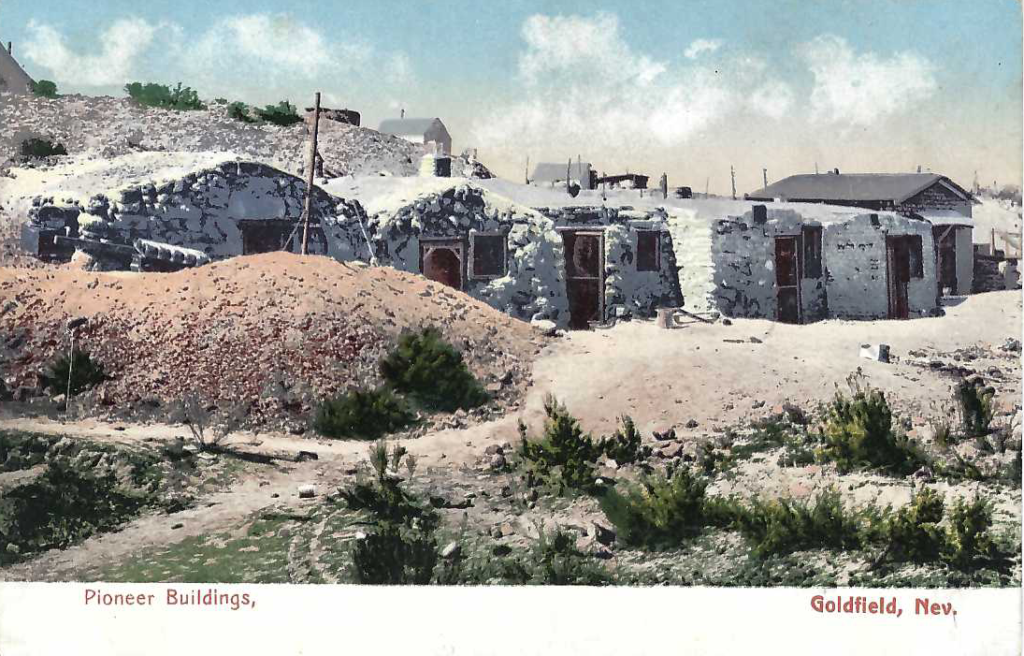
He also used the Denver Engraving Company to print a black and white version with an undivided back in 1906.
Next to the Pioneer Building “cut” in the January 9, 1909 issue of The Goldfield News, the paper printed, “Goldfield has not entirely outgrown the old dug-out, cabins, and shacks, for many of them are still in use. But as the town and the camp prospered and gave indications of permanency, people began to plan to live with all the comforts obtainable. The old dugout, cabins made of tin cans and bottles are still in evidence, however, to remind one of the vicissitudes of the early pioneers.”
According to the newspaper story, the town may have changed, but as of January 1909, they were “still in use.”
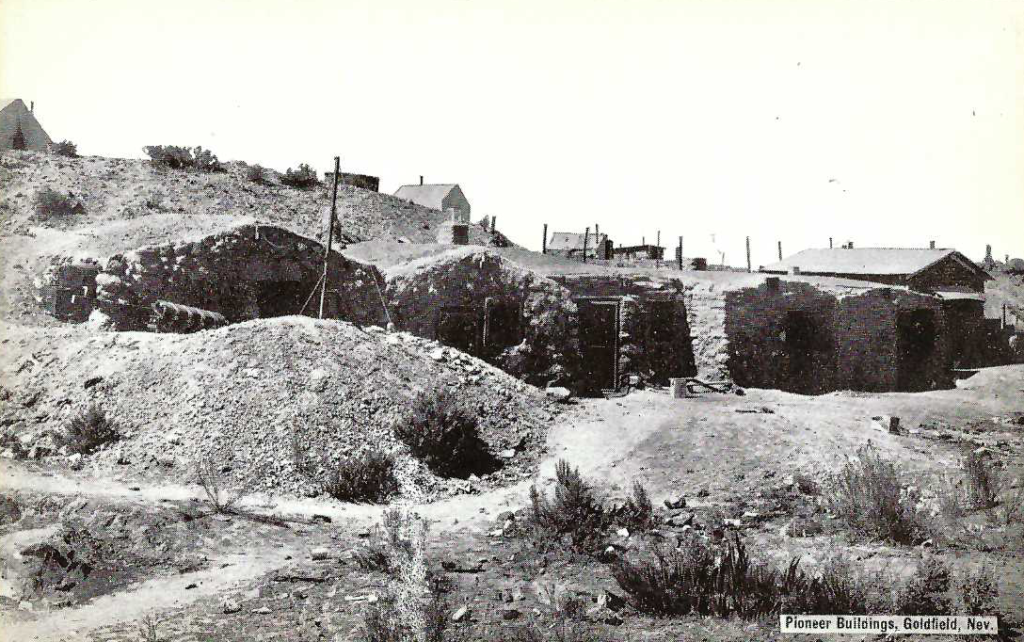
Larson used the image once again in the fall of 1907 and for the second time, he paid for a colorized version.
This time Larson used the Newman Post Card Company of Los Angeles to have the card printed in Germany. The divided back card is part of Larson’s Goldfield 134 series of more than 25 post cards.
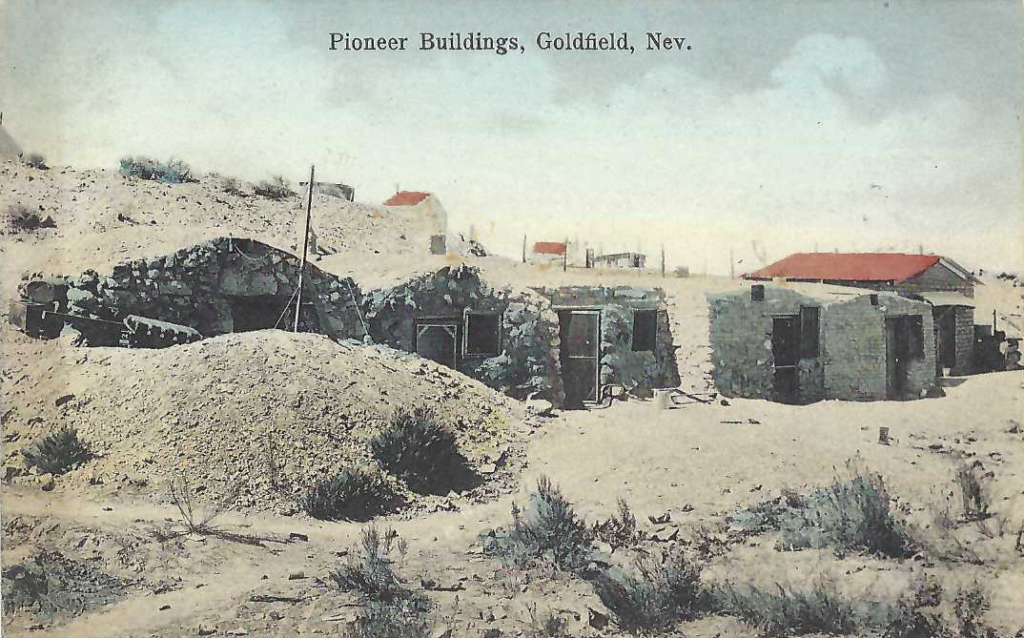
25 One of Goldfield’s Heaviest Producing Leases.
The caption on this post card is one of three post cards in the series that does not end with “Goldfield, Nev.”
33 – 20 Head Mule Team en route to Death Valley, via Goldfield, Nev.
This is a Larson photograph.
Larson also published his photograph as a color post card printed in Germany through the Newman post card company of Los Angeles.
The Goldfield News used the same caption Larson used for his post card except that the newspaper used the actual number 20 rather than spelling it.
The caption on Larson’s card reads, Twenty head Mule team En Route to Death Valley via, Goldfield, Nev.
The Backs of the Post Cards
The backs of the post cards published by the Goldfield newspapers provide clues to the images’ age. The backs also help determine who and when the post cards were printed.
The different backs used in reprinting cycles provide a clue as to the popularity of specific post cards.
The order of the backs is in two parts. First, the Tribune Book and Stationery Store, followed by The Goldfield News newspaper.
Postmarks and newspaper announcements are the primary sources used to list the order of the different backs.
Known back variations.
1. TRIBUNE BOOK AND STATIONERY STORE GOLDFIELD, NEVADA (Straight center line back.)
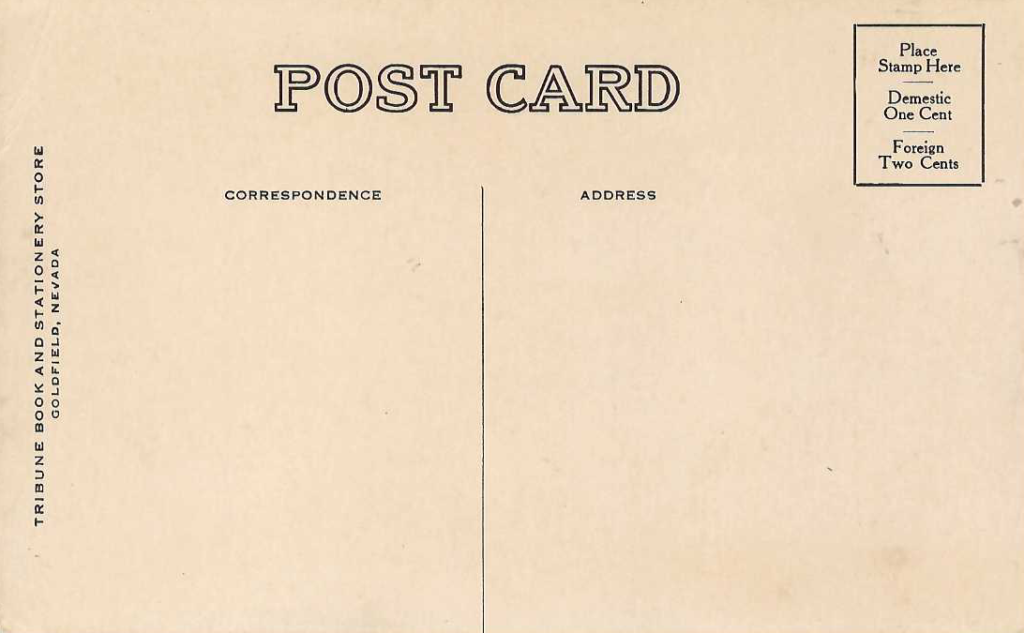
2. TRIBUNE BOOK AND STATIONERY STORE GOLDFIELD, NEVADA (U.S. flag around the spear.)
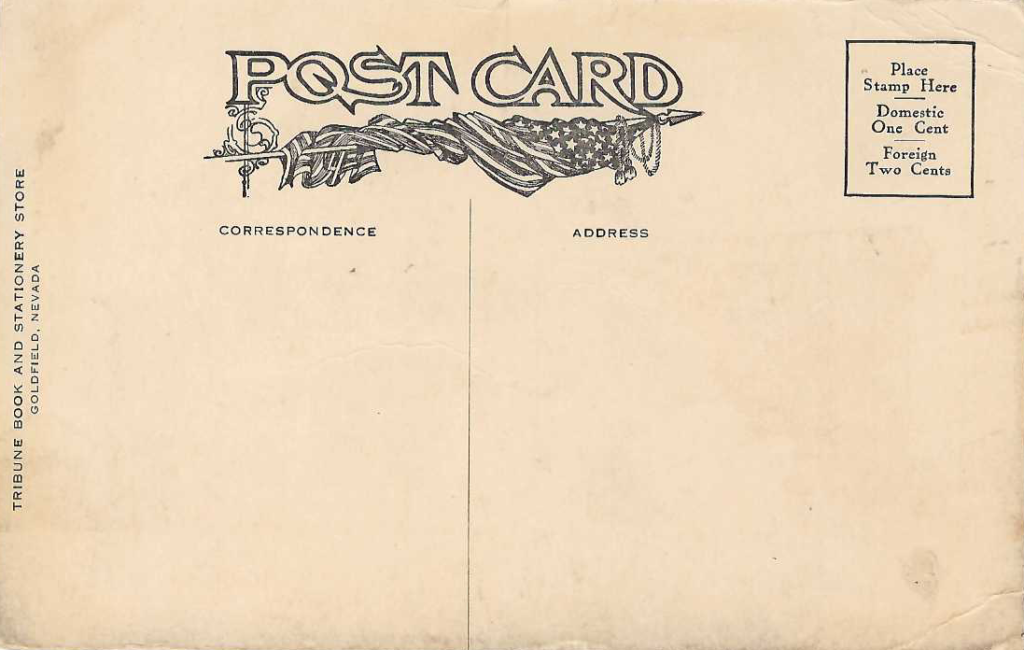
3. Copyrighted by GOLDFIELD NEWS, Publisher, Goldfield, Nev. (U.S. flag around the spear.)
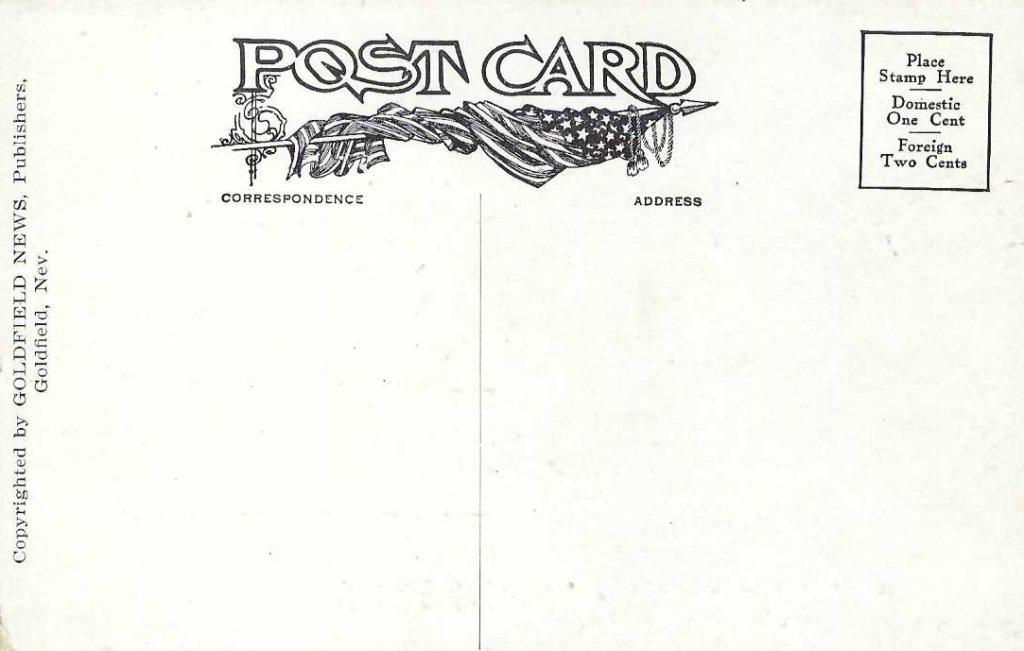
4. THE NEWS, Publishers, Goldfield, Nev. (U.S. flag around spear.)

5. THE NEWS, Publisher, Goldfield, Nevada. (U.S. Flag around spear.)
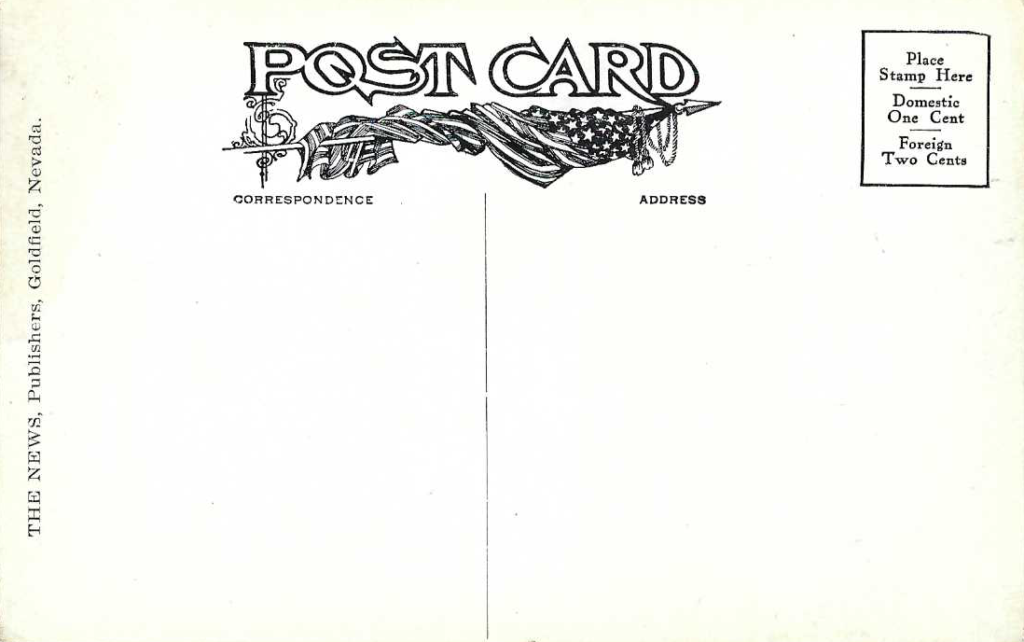
6. THE NEWS, Publisher, Goldfield, Nevada. (Small font. U.S. flag around the spear.)
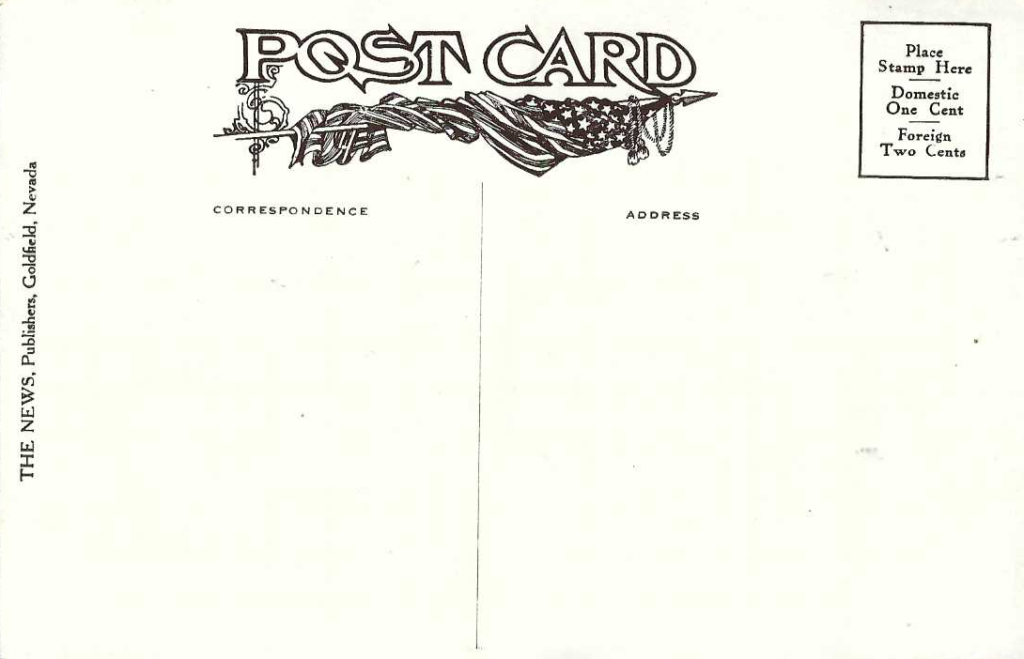
7. THE NEWS, Publisher, Goldfield, Nev. (Post Card shield.)
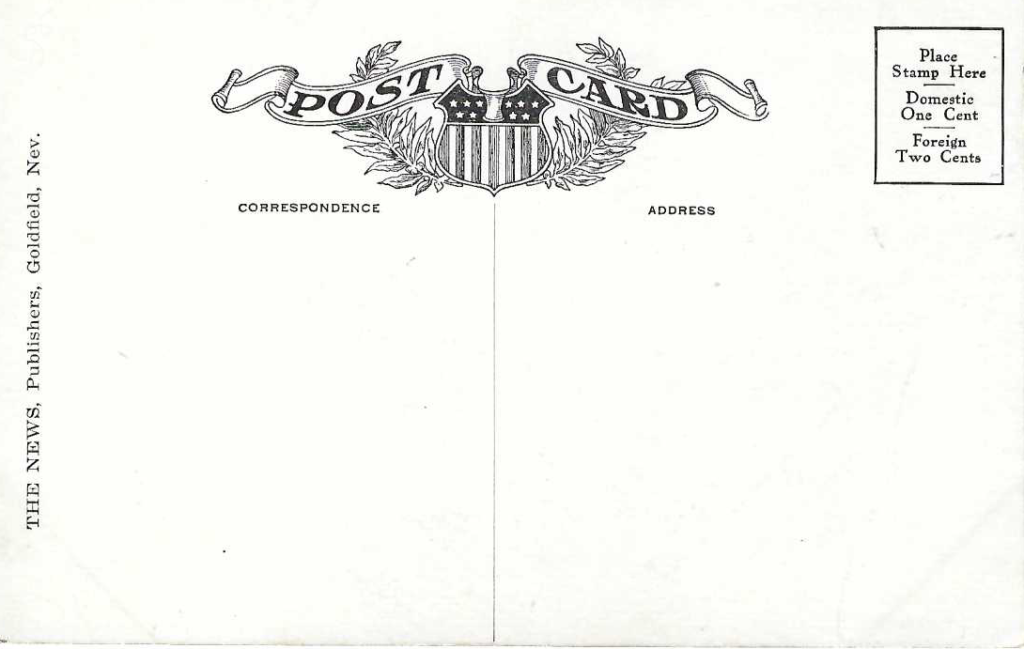
8. THE NEWS, Publisher, Goldfield, Nevada. (Post Card shield.)
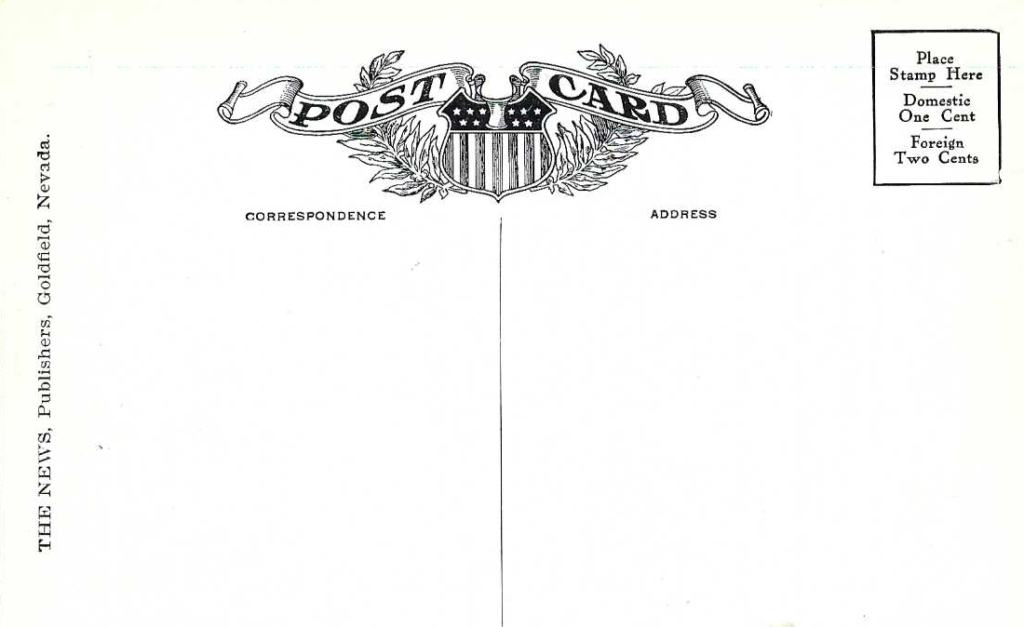
Notes about the different Backs
Tribune Book and Stationery Store
Two different versions of post cards with the credit line “TRIBUNE BOOK AND STATIONERY STORE GOLDFIELD, NEVADA” have been uncovered.
One post card has a simple vertical line dividing the back, and the other Tribune card has a U.S. flag wrapped around a spear below the words POST CARD in a different font.
No postmarks have been uncovered on the post card with a simple vertical line dividing the back.
However, the other version of the Tribune Book post card, with the back that has a U.S. flag wrapped around a spear back, has been seen with postmarks dating the cards to December 1908.
It is likely the newspaper had unsold stock with both versions of the backs of the post card. Unsold post cards of the two newspapers were used in the teens as a receipt to newspaper subscribers.
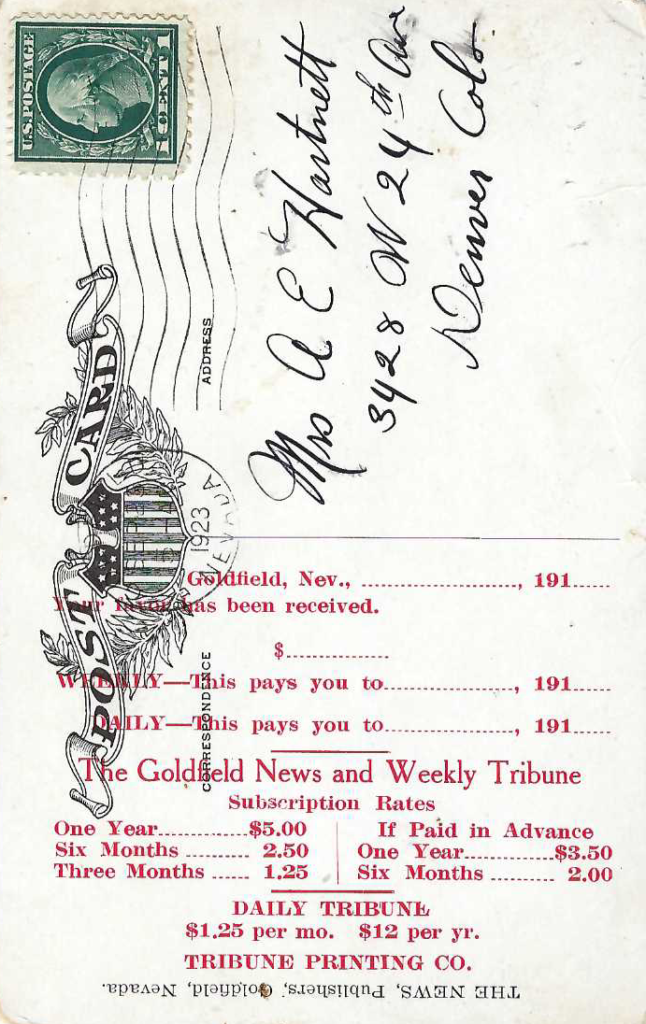 The postmark is 1923, but the receipt information is 191… (?)
The postmark is 1923, but the receipt information is 191… (?)
This receipt is found on the back of post card 10 “High School Assembly, Goldfield, Nev.” The same information is also found on card 32 Nevada-Goldfield Reduction Works, Goldfield, Nev.
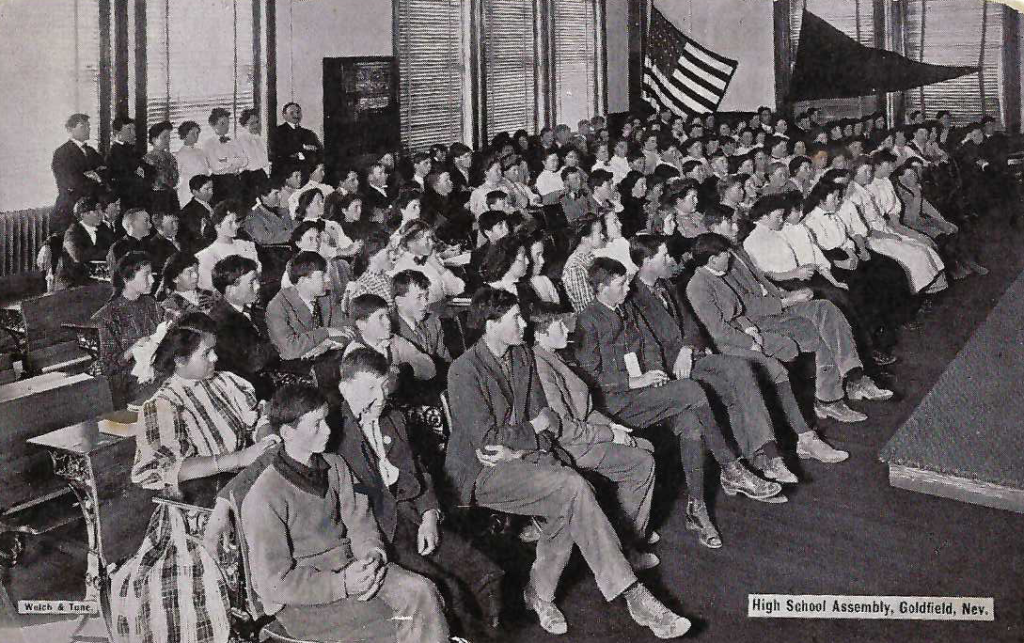
In addition, Tribune post cards of the Goldfield Hotel were used in 1921 with an overprint listing the new hotel operators and the location “on the Midland Trail.”
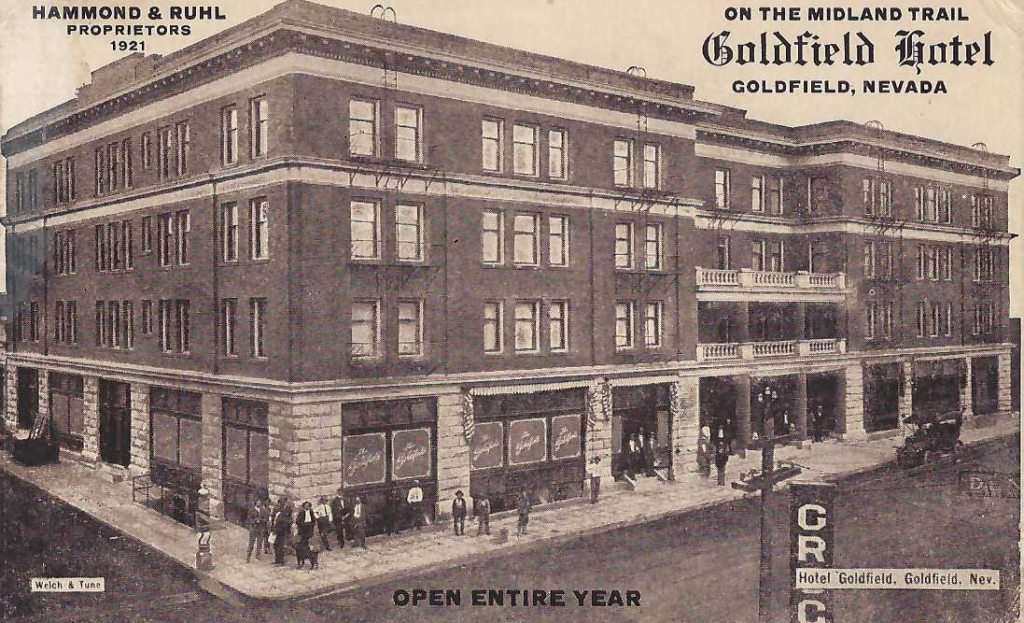
To date, only one post card with the Tribune back showing the U.S. Flag around a spear with the copyrighted note has been uncovered one post card. The caption on the card describes the image in detail; “First picture taken in Goldfield, December 1903. Harrie Taylor (discover). Lew Finnegan and John Y. McKame on the Jumbo, from which was taken $100,000 in 47 feet from the surface, the strike that caused the first rush.”
Shield Backs 7 and 8
Based on advertisements in The Goldfield News newspaper and on post marks, “THE NEWS” post cards with the shield back went on sale in January 1909.
Based on a limited number of post marks, it appears the shield back with Nevada abbreviated to “Nev.” went on sale in the winter of 1908.
The post cards with the shield back and the full spelling of Nevada first went on sale in January of 1909.
Abbreviations
Two sets of abbreviations are found in this report.
The first set of abbreviations are those found on the post cards.
The second set of abbreviations are those used in this report.
As a general rule, abbreviations are used when space is limited. Accepted abbreviations at the time the post cards were printed included “Nev.” for Nevada, “St.” for street, and “Ave.” for avenue.
The ampersand “&” is not used as an abbreviation on post card 14. “Interior Jno. S. Cook & Co., Goldfield, Nev.”
The “&” is part of the legal title of the company, “John S. Cook & Company.”
And, “&” is part of the legal name of Welch & Tune.
With 64 characters and spaces, the longest caption is number thirty-two, “20 Head Mule Team en route to Death Valley, via Goldfield, Nev.”
This brings us back to post card 14, “Interior Jno. S. Cook & Co., Goldfield, Nev.”
While “Jno.” is the correct abbreviation for John, why is John abbreviated to “Jno.”? The caption only uses forty-four spaces and characters compared to the 64 spaces and characters in the mule team post card.
On post card number four, the two words post office become one-word, postoffice.
In this report, (v) indicates the post card was printed as a vertical view.
Notice
Mistakes, additions, and any improvement suggestions are WELCOME. Please email bigfootnote.com thank you Robert Stoldal
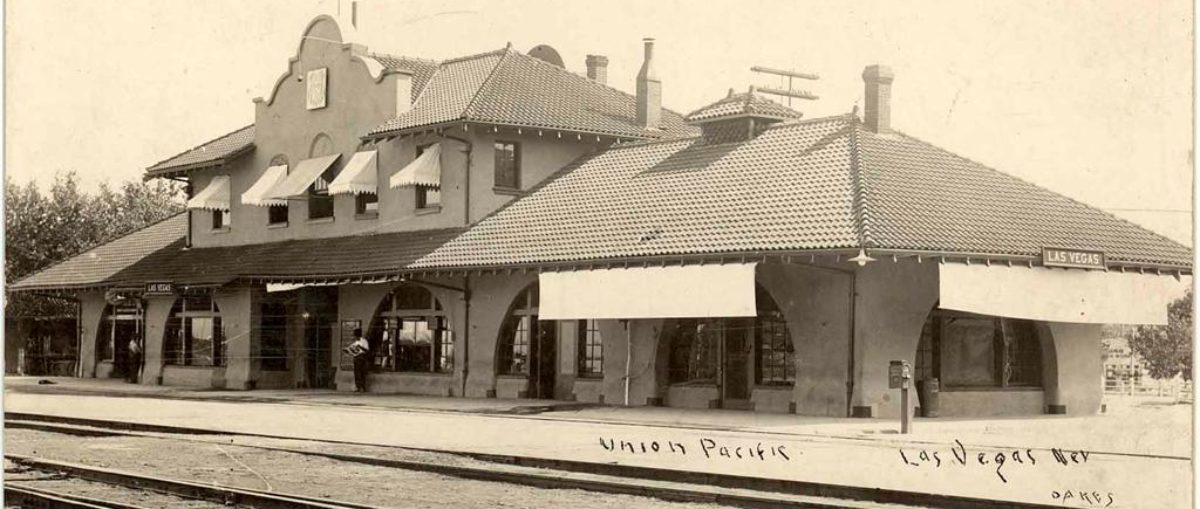
Another fine piece of historical research that I enjoyed reading. Wonderful postcards and history.
Thank you for posting.